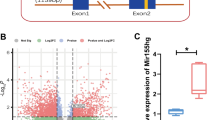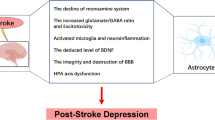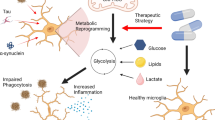Abstract
MicroRNAs (miRNAs) regulate gene expression at the post-transcriptional level. The miRNA miR-106b-5p has been linked to epilepsy, but its specific role and mechanism of action remain unclear. This was investigated in the present study using a mouse model of pilocarpine-induced status epilepticus and an in vitro system of HT22 hippocampal cells treated with Mg2+-free solution and cocultured with BV2 microglia cells. We found that inhibiting miR-106b-5p expression promoted microglia M2 polarization, reduced the inflammatory response, and alleviated neuronal injury. These effects involved modulation of the repulsive guidance molecule A (RGMa)–Rac1–c-Jun N-terminal kinase (JNK)/p38–mitogen-activated protein kinase (MAPK) signaling axis. Our results suggest that therapeutic strategies targeting miR-106b-5p or downstream factors can be effective in preventing epileptogenesis or treating epilepsy.













Similar content being viewed by others
DATA AVAILABILITY
All data generated or analyzed in this study are included in this article. The datasets used and/or analyzed in the study are available from the corresponding author on reasonable request.
References
Fiest, K.M., K.M. Sauro, S. Wiebe, S.B. Patten, C.S. Kwon, J. Dykeman, et al. 2017. Prevalence and incidence of epilepsy: A systematic review and meta-analysis of international studies. Neurology 88: 296–303.
Thurman, D.J., C.E. Begley, A. Carpio, S. Helmers, D.C. Hesdorffer, J. Mu, et al. 2018. The primary prevention of epilepsy: A report of the Prevention Task Force of the International League Against Epilepsy. Epilepsia 59: 905–914.
Kalilani, L., X. Sun, B. Pelgrims, M. Noack-Rink, and V. Villanueva. 2018. The epidemiology of drug-resistant epilepsy: A systematic review and meta-analysis. Epilepsia 59: 2179–2193.
Aronica, E., K. Fluiter, A. Iyer, E. Zurolo, J. Vreijling, E.A. van Vliet, et al. 2010. Expression pattern of miR-146a, an inflammation-associated microRNA, in experimental and human temporal lobe epilepsy. European Journal of Neuroscience 31: 1100–1107.
Korotkov, A., D. Broekaart, L. Banchaewa, B. Pustjens, J. van Scheppingen, J.J. Anink, et al. 2020. microRNA-132 is overexpressed in glia in temporal lobe epilepsy and reduces the expression of pro-epileptogenic factors in human cultured astrocytes. Glia 68: 60–75.
Zhao, X., Y. Liao, S. Morgan, R. Mathur, P. Feustel, J. Mazurkiewicz, et al. 2018. Noninflammatory changes of microglia are sufficient to cause epilepsy. Cell Reports 22: 2080–2093.
Broekaart, D., J.J. Anink, J.C. Baayen, S. Idema, H.E. de Vries, E. Aronica, et al. 2018. Activation of the innate immune system is evident throughout epileptogenesis and is associated with blood-brain barrier dysfunction and seizure progression. Epilepsia 59: 1931–1944.
Crespel, A., P. Coubes, M.C. Rousset, C. Brana, A. Rougier, G. Rondouin, et al. 2002. Inflammatory reactions in human medial temporal lobe epilepsy with hippocampal sclerosis. Brain Research 952: 159–169.
Najjar, S., D. Pearlman, D.C. Miller, and O. Devinsky. 2011. Refractory epilepsy associated with microglial activation. The Neurologist 17: 249–254.
Benson, M.J., S. Manzanero, and K. Borges. 2015. Complex alterations in microglial M1/M2 markers during the development of epilepsy in two mouse models. Epilepsia 56: 895–905.
Colonna, M., and O. Butovsky. 2017. Microglia function in the central nervous system during health and neurodegeneration. Annual Review of Immunology 35: 441–468.
Luo, C., R. Koyama, and Y. Ikegaya. 2016. Microglia engulf viable newborn cells in the epileptic dentate gyrus. Glia 64: 1508–1517.
Wyatt-Johnson, S.K., and A.L. Brewster. 2020. Emerging roles for microglial phagocytic signaling in epilepsy. Epilepsy Currents 20: 33–38.
Andoh, M., Y. Ikegaya, and R. Koyama. 2019. Synaptic pruning by microglia in epilepsy. Journal of Clinical Medicine 8: 2170.
Sun, X., J. Sun, X. Shao, J. Feng, J. Yan, and Y. Qin. 2018. Inhibition of microRNA-155 modulates endotoxin tolerance by upregulating suppressor of cytokine signaling 1 in microglia. Experimental and Therapeutic Medicine 15: 4709–4716.
Yu, A., T. Zhang, H. Duan, Y. Pan, X. Zhang, G. Yang, et al. 2017. MiR-124 contributes to M2 polarization of microglia and confers brain inflammatory protection via the C/EBP-α pathway in intracerebral hemorrhage. Immunology Letters 182: 1–11.
Tao, Y., Z. Wang, L. Wang, J. Shi, X. Guo, W. Zhou, et al. 2017. Downregulation of miR-106b attenuates inflammatory responses and joint damage in collagen-induced arthritis. Rheumatology (Oxford, England) 56: 1804–1813.
Li, P., M. Shen, F. Gao, J. Wu, J. Zhang, F. Teng, et al. 2017. An antagomir to microRNA-106b-5p ameliorates cerebral ischemia and reperfusion injury in rats via inhibiting apoptosis and oxidative stress. Molecular Neurobiology 54: 2901–2921.
Li, J.Q., J.M. Tian, X.R. Fan, Z.Y. Wang, J. Ling, X.F. Wu, et al. 2020. miR-106b-5p induces immune imbalance of Treg/Th17 in immune thrombocytopenic purpura through NR4A3/Foxp3 pathway. Cell Cycle 19: 1265–1274.
An, N., W. Zhao, Y. Liu, X. Yang, and P. Chen. 2016. Elevated serum miR-106b and miR-146a in patients with focal and generalized epilepsy. Epilepsy Research 127: 311–316.
Zhao, J., Y. Sang, Y. Zhang, D. Zhang, J. Chen, and X. Liu. 2019. Efficacy of levetiracetam combined with sodium valproate on pediatric epilepsy and its effect on serum miR-106b in children. Experimental and Therapeutic Medicine 18: 4436–4442.
Lin, Q., J. Chen, X. Zheng, Y. Zhang, X. Tao, and J. Ye. 2020. Circular RNA circ_ANKMY2 regulates temporal lobe epilepsy progression via the miR-106b-5p/FOXP1 axis. Neurochemical Research 45: 3034–3044.
Zheng, D., M. Li, G. Li, J. Hu, X. Jiang, Y. Wang, et al. 2021. Circular RNA circ_DROSHA alleviates the neural damage in a cell model of temporal lobe epilepsy through regulating miR-106b-5p/MEF2C axis. Cellular Signalling 80: 109901.
Siebold, C., T. Yamashita, P.P. Monnier, B.K. Mueller, and R.J. Pasterkamp. 2017. RGMs: Structural insights, molecular regulation, and downstream signaling. Trends in Cell Biology 27: 365–378.
De Vries, M., and H.M. Cooper. 2008. Emerging roles for neogenin and its ligands in CNS development. Journal of Neurochemistry 106: 1483–1492.
Xia, Y., P.B. Yu, Y. Sidis, H. Beppu, K.D. Bloch, A.L. Schneyer, et al. 2007. Repulsive guidance molecule RGMa alters utilization of bone morphogenetic protein (BMP) type II receptors by BMP2 and BMP4. The Journal of Biological Chemistry 282: 18129–18140.
Tanabe, S., Y. Fujita, K. Ikuma, and T. Yamashita. 2018. Inhibiting repulsive guidance molecule-a suppresses secondary progression in mouse models of multiple sclerosis. Cell Death & Disease 9: 1061.
Tanabe, S., and T. Yamashita. 2014. Repulsive guidance molecule-a is involved in Th17-cell-induced neurodegeneration in autoimmune encephalomyelitis. Cell Reports 9: 1459–1470.
Harada, K., Y. Fujita, T. Okuno, S. Tanabe, Y. Koyama, H. Mochizuki, et al. 2018. Inhibition of RGMa alleviates symptoms in a rat model of neuromyelitis optica. Scientific Reports 8: 34.
Nakagawa, H., T. Ninomiya, T. Yamashita, and M. Takada. 2019. Treatment with the neutralizing antibody against repulsive guidance molecule-a promotes recovery from impaired manual dexterity in a primate model of spinal cord injury. Cerebral Cortex 29: 561–572.
Korecka, J.A., E.B. Moloney, R. Eggers, B. Hobo, S. Scheffer, N. Ras-Verloop, et al. 2017. Repulsive guidance molecule a (RGMa) induces neuropathological and behavioral changes that closely resemble Parkinson’s disease. The Journal of Neuroscience 37: 9361–9379.
Yu, T., H. Fu, J.J. Sun, D.R. Ding, and H. Wang. 2021. miR-106b-5p upregulation is associated with microglial activation and inflammation in the mouse hippocampus following status epilepticus. Experimental Brain Research 239: 3315–3325.
Zhu, X., Y. Yao, Y. Liu, R. Zhou, W. Zhang, Q. Hu, et al. 2019. Regulation of ADAM10 by microRNA-23a contributes to epileptogenesis in pilocarpine-induced status epilepticus mice. Frontiers in Cellular Neuroscience 13: 180.
Ren, X.Q., R. Ma, C.Q. Yang, Q.H. Liu, J. Jiao, X.L. Zhang, et al. 2016. Kangxian capsules: Effects on convulsive injuries, N-methyl-d-aspartate (NMDA) receptor subunit expression, and free Ca(2+) concentration in a rat hippocampal neuron epileptic discharge model. Seizure 40: 27–32.
Li, T., X. Zhai, J. Jiang, X. Song, W. Han, J. Ma, et al. 2017. Intraperitoneal injection of IL-4/IFN-γ modulates the proportions of microglial phenotypes and improves epilepsy outcomes in a pilocarpine model of acquired epilepsy. Brain Research 1657: 120–129.
Becker, A.J. 2018. Review: Animal models of acquired epilepsy: Insights into mechanisms of human epileptogenesis. Neuropathology and Applied Neurobiology 44: 112–129.
Engel, J., Jr., and A. Pitkänen. 2020. Biomarkers for epileptogenesis and its treatment. Neuropharmacology 167: 107735.
Terrone, G., A. Salamone, and A. Vezzani. 2017. Inflammation and epilepsy: Preclinical findings and potential clinical translation. Current Pharmaceutical Design 23: 5569–5576.
Tang, Y., and W. Le. 2016. Differential roles of M1 and M2 microglia in neurodegenerative diseases. Molecular Neurobiology 53: 1181–1194.
Therajaran, P., J.A. Hamilton, T.J. O’Brien, N.C. Jones, and I. Ali. 2020. Microglial polarization in posttraumatic epilepsy: Potential mechanism and treatment opportunity. Epilepsia 61: 203–215.
Ransohoff, R.M. 2016. A polarizing question: do M1 and M2 microglia exist? Nature Neuroscience 19 (8): 987–91. https://doi.org/10.1038/nn.4338. PMID: 27459405.
Hu, X., R.K. Leak, Y. Shi, J. Suenaga, Y. Gao, P. Zheng, et al. 2015. Microglial and macrophage polarization—new prospects for brain repair. Nature Reviews. Neurology 11: 56–64.
Heo, K., Y.-J. Cho, K.-J. Cho, H.-W. Kim, H.-J. Kim, H.Y. Shin, et al. 2006. Minocycline inhibits caspase-dependent and -independent cell death pathways and is neuroprotective against hippocampal damage after treatment with kainic acid in mice. Neuroscience Letters 398: 195–200.
Abraham, J., P.D. Fox, C. Condello, A. Bartolini, and S. Koh. 2012. Minocycline attenuates microglia activation and blocks the long-term epileptogenic effects of early-life seizures. Neurobiology of Disease 46: 425–430.
Feng, L., M. Murugan, D.B. Bosco, Y. Liu, J. Peng, G.A. Worrell, et al. 2019. Microglial proliferation and monocyte infiltration contribute to microgliosis following status epilepticus. Glia 67: 1434–1448.
Scott, A.J., L. Sharpe, C. Hunt, and M. Gandy. 2017. Anxiety and depressive disorders in people with epilepsy: A meta-analysis. Epilepsia 58: 973–982.
Pineda, E., D. Shin, R. Sankar, and A.M. Mazarati. 2010. Comorbidity between epilepsy and depression: Experimental evidence for the involvement of serotonergic, glucocorticoid, and neuroinflammatory mechanisms. Epilepsia 51: 110–114.
Shen, Y., W. Peng, Q. Chen, B.D. Hammock, J. Liu, D. Li, et al. 2019. Anti-inflammatory treatment with a soluble epoxide hydrolase inhibitor attenuates seizures and epilepsy-associated depression in the LiCl-pilocarpine post-status epilepticus rat model. Brain, Behavior, and Immunity 81: 535–544.
Kanner, A.M. 2011. Depression and epilepsy: A bidirectional relation? Epilepsia 52: 21–27.
Vezzani, A., B. Lang, and E. Aronica. 2015. Immunity and inflammation in epilepsy. Cold Spring Harbor Perspectives in Medicine 6: a022699.
Xu, X., Y. Gao, F. Shan, and J. Feng. 2016. A novel role for RGMa in modulation of bone marrow-derived dendritic cells maturation induced by lipopolysaccharide. International Immunopharmacology 33: 99–107.
Muramatsu, R., T. Kubo, M. Mori, Y. Nakamura, Y. Fujita, T. Akutsu, et al. 2011. RGMa modulates T cell responses and is involved in autoimmune encephalomyelitis. Nature Medicine 17: 488–494.
Körner, A., M. Schlegel, T. Kaussen, V. Gudernatsch, G. Hansmann, T. Schumacher, et al. 2019. Sympathetic nervous system controls resolution of inflammation via regulation of repulsive guidance molecule A. Nature Communications 10: 633.
Oda, W., Y. Fujita, K. Baba, H. Mochizuki, H. Niwa, and T. Yamashita. 2021. Inhibition of repulsive guidance molecule-a protects dopaminergic neurons in a mouse model of Parkinson’s disease. Cell Death & Disease 12: 181.
Bishop, A.L., and A. Hall. 2000. Rho GTPases and their effector proteins. The Biochemical journal 348: 241–255.
D’Ambrosi, N., S. Rossi, V. Gerbino, and M. Cozzolino. 2014. Rac1 at the crossroad of actin dynamics and neuroinflammation in Amyotrophic Lateral Sclerosis. Frontiers in Cellular Neuroscience 8: 279.
Persson, A.K., M. Estacion, H. Ahn, S. Liu, S. Stamboulian-Platel, S.G. Waxman, et al. 2014. Contribution of sodium channels to lamellipodial protrusion and Rac1 and ERK1/2 activation in ATP-stimulated microglia. Glia 62: 2080–2095.
Xu, Y., W. Hu, Y. Liu, P. Xu, Z. Li, R. Wu, et al. 2016. P2Y6 receptor-mediated microglial phagocytosis in radiation-induced brain injury. Molecular Neurobiology 53: 3552–3564.
De Caris, M.G., M. Grieco, E. Maggi, A. Francioso, F. Armeli, L. Mosca, et al. 2020. Blueberry counteracts BV-2 microglia morphological and functional switch after LPS challenge. Nutrients 12: 1830.
Bianchi, R., I. Giambanco, and R. Donato. 2010. S100B/RAGE-dependent activation of microglia via NF-kappaB and AP-1 co-regulation of COX-2 expression by S100B, IL-1beta and TNF-alpha. Neurobiology of Aging 31: 665–677.
Liu, Q., Y. Zhang, S. Liu, Y. Liu, X. Yang, G. Liu, et al. 2019. Cathepsin C promotes microglia M1 polarization and aggravates neuroinflammation via activation of Ca-dependent PKC/p38MAPK/NF-κB pathway. Journal of Neuroinflammation 16: 10.
Plastira, I., E. Bernhart, L. Joshi, C.N. Koyani, H. Strohmaier, H. Reicher, et al. 2020. MAPK signaling determines lysophosphatidic acid (LPA)-induced inflammation in microglia. Journal of Neuroinflammation 17: 127.
Kim, E.K., and E.J. Choi. 2015. Compromised MAPK signaling in human diseases: An update. Archives of Toxicology 89: 867–882.
Kaminska, B., Gozdz, A., Zawadzka, M., Ellert-Miklaszewska, A., and Lipko, M. 2009. MAPK signal transduction underlying brain inflammation and gliosis as therapeutic target. Anatomical Record (Hoboken, N.J.: 2007) 292: 1902–1913.
ACKNOWLEDGEMENTS
Not applicable.
Funding
This work was supported by grants from CAAE Epilepsy Research Fund (CX-B-2021–02).
Author information
Authors and Affiliations
Contributions
All authors contributed to study conception and design. The first draft of the manuscript was written by Tao Yu, and all authors commented on previous versions of the manuscript and read and approved the final manuscript.
Corresponding author
Ethics declarations
Ethics Approval
Animal experiments were approved by the Animal Ethics Committee of Shengjing Hospital Affiliated with China Medical University (no. 2020PS505K).
Consent for Publication
All authors read, approved, and consented to publish the final manuscript.
Competing Interests
The authors have no relevant financial or non-financial interests to disclose.
Additional information
Publisher's Note
Springer Nature remains neutral with regard to jurisdictional claims in published maps and institutional affiliations.
Supplementary Information
Below is the link to the electronic supplementary material.
Rights and permissions
About this article
Cite this article
Yu, T., Huo, L., Lei, J. et al. Modulation of Microglia M2 Polarization and Alleviation of Hippocampal Neuron Injury By MiR-106b-5p/RGMa in a Mouse Model of Status Epilepticus. Inflammation 45, 2223–2242 (2022). https://doi.org/10.1007/s10753-022-01686-1
Received:
Revised:
Accepted:
Published:
Issue Date:
DOI: https://doi.org/10.1007/s10753-022-01686-1




